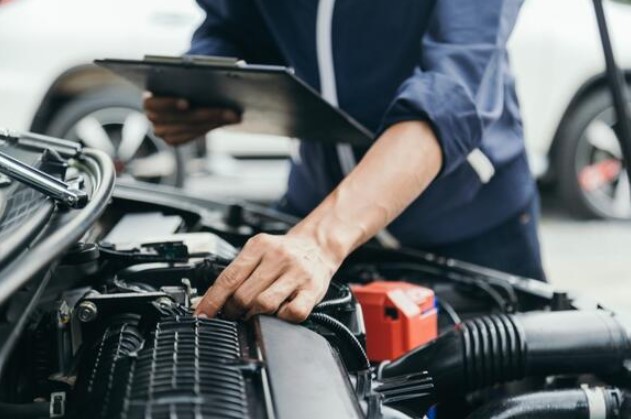Shift quality of shifting process
Shifting from a current forward speed ratio to a desired forward speed ratio requires that the clutching device associated with the current speed ratio be disengagement and the clutching device associated with the desired speed ratio be engagement. In its basic form, the control system directs the supply of fluid pressure to the transmission clutching devices in accordance with the control law table derived from empiricism. However, engine and transmission operating characteristics do change with time, and the production assembly tolerances may result in significant vehicle-to-vehicle variability. As a result, control schedules that produce acceptable ratio shifting in one vehicle may produce unacceptable ratio shifting in another vehicle. Hence, the controller needs to develop corrections for the empirically derived schedules involved in the shifting process so that when the shifting process is repeated at a later point, it will be performed in a more nearly optimum manner.
As explained below, the timing of such disengagement of off-going clutch and engagement of on-coming clutch is critical to the attainment of high-quality shifting process. If the on-coming clutch begins developing torque capacity with inappropriate fill time, the exchange of torque capacity between the off-going and on-coming clutch will not proceed according to schedule. In this regard, the graph of underfill errors and overfill errors can be illustrated as Fig. 4a,b, respectively. Similarly, the graph of the inertia phase duration errors which is too short or too long are illustrated in Fig. 5a,b respectively.

Shifting of underfill and overfill errors.

Shifting of low-pressure and high-pressure errors.
Figure 4a is a 60 percent throttle gear 4 to gear 5 power on upshift with overfill errors. Figure 4b is a 50 percent throttle 3–4 power on upshift with underfill errors. Figure 5a,b are gear 3 to gear 4 power on upshifts at 30 and 80 percent throttles with high-pressure and low-pressure errors, respectively.
In order to evaluate the quality of a shifting process and decide whether to adopt a compensation strategy21, literature22 summarizes all the indicator parameters of the shift quality, the expressions are as follows.
$$beginarraylQ_s=left[ J_s, T_s, omega _s, delta _sright]endarray$$
(4)
where (Q_s) is the shift quality, (J_s) is the rate of change of the transmission output torque which can be expressed as Eq. (5), (T_s) is the time for transmission between two gears, (omega _s) is transmission output angular velocity deviation, (delta _s) is angular acceleration change rate.
$$beginarraylJ_s=fracdT_0(t)dtendarray$$
(5)
(delta _s) can be expressed as Eq. (6)
$$beginarraycdelta _s=fracdtheta (t)dt=fracs+1r_wfracda(t)dtendarray$$
(6)
where (theta (t)) is the angular acceleration of transmission output shaft, (r_w) is tire radius, (s) is constant tire slip, (a(t)) is the linear acceleration of vehicle.
The vehicle driving dynamics equation is expressed as Eq. (7).
$$beginarraycF_t=F_f+F_w+F_i+F_jendarray$$
(7)
(F_t) represents the tangential reaction force of the ground acting on the driving wheel, its expression is shown in Eq. (8). Where (T_0) is transmission output torque, (i_0) is main reduction gear ratio, (eta _0) is the drivetrain mechanical efficiency from transmission output to wheels.
$$beginarraycF_t=T_0i_0eta _0endarray$$
(8)
(F_f) represents the rolling resistance and its expression is shown in Eq. (9). Where (m) is the vehicle weight, (g) is the acceleration of gravity, (f) is the coefficient of rolling resistance, (alpha) is the ramp angle.
$$beginarraycF_f=mgfcosalpha endarray$$
(9)
(F_w) represents the wind resistance, its expression is shown in Eq. (10). Where (C_D) is the air drag coefficient, (A) is the windward area of vehicle driving direction, (u) is the velocity of air relative to the vehicle.
$$beginarraycF_w=fracC_DAu^221.15endarray$$
(10)
(F_i) represents ramp resistance, its expression is shown in Eq. (11).
$$beginarraycF_i=mgsinalpha endarray$$
(11)
(F_j) represents vehicle acceleration resistance, its expression is shown in Eq. (12). (delta) is the conversion factor of the rotating mass of the car after taking into account the moment of inertia of the rotating mass.
$$beginarraycF_j=delta mfracdudtendarray$$
(12)
Substituting Eqs. (8), (9), (10), (11), (12) into Eq. (7).
$$beginarraycT_0i_0eta _0=mgfcosalpha +fracC_DAu^221.15+mgsinalpha +delta mfracdudtendarray$$
(13)
Differentiating Eq. (13), we can get Eq. (14).
$$beginarraycfracdT_0(t)dt=frac1i_0eta _0left(frac2C_DAu(t)a(t)21.15+delta mfracda(t)dtright)endarray$$
(14)
From Eq. (14), we can see that when the vehicle speed and longitudinal acceleration are relatively small, the rate of change of (T_0(t)) is almost linearly related to the rate of change of (a(t)), while the rate of change of (T_0(t)) has more effect on the rate of change of (a(t)) when the vehicle speed and longitudinal acceleration are increasing. This is consistent with the vehicle jerk perceived by the passengers on real vehicle.
Using above results, and ignoring the influence of the wind resistance sub-item on the shifting quality, the expressions of the shift quality defined as Eq. (15).
$$beginarraycQ_s=q_1left|T_s-T_bestright|+q_2int left|omega (t)-omega _0(t)right|dt+q_3int left|fracda(t)dtright|dtendarray$$
(15)
where (q_1), (q_2), (q_3), represent the weight coefficients of sub-items, (omega (t)) represents the actual speed, (omega _0(t)) represents the desired speed, (T_best) denotes the optimal time determined by empiricism.
Adaptive control strategy for the torque phase
Figure 4 shows the clutch tie-up curve and the engine flare curve, both of which, although occurring during the torque phase, are caused by inappropriate filling time. The filling time is usually not constant because of the engine and transmission operating characteristics changing with vehicle-to-vehicle variability and wear of the clutch during the life cycle. The use of manual calibration methods for filling time to compensate for this variation is not applicable to the market.
In order to adaptively adjust the filling time, we need to calculate the speed deviation of the torque phase and determine whether it is engine flare or clutch tie-up. Figure 6 shows the calculation principle of the input speed deviation degree with clutch tie-up and engine flare.

Principle of speed deviation for the torque phase.
As showing in Fig. 6, the calculation principle of the speed deviation of clutch tie-up and engine flare is basically the same, and the key is the establishment of the desired speed curve. The expected speed curve consists of two linear fitting curves L1 and L2. L1 is a curve fitted linearly by the engine speed between T1 and T2, and L2 is a curve fitted linearly by the engine speed between T3 and T4. Taking into account the time-delay characteristics of the actual solenoid valve control command and hydraulic system response, the rules for selecting the time points of the fitting time period are as follows: T1 is the point in time when a shifting request is generated and the shifting starts; T2 is the time point when the oil drain solenoid valve is fully opened; T3 equals T2 plus torque phase time(In this paper the torque phase time (Delta T_torque) is 0.2 s) as shown in Eq. (16); T4 is the time point when the transmission input speed reaches the target gear speed.
$$beginarraycT_3=T_2+Delta T_torqueendarray$$
(16)
Assuming that the desired speed curve (X_L) composed of L1 and L2 is L, its discrete expression is shown in Eq. (17). The discrete expression of the line segment representing the actual acquisition speed is shown in Eq. (18). The discrete expression of the line segment representing the output speed is shown in Eq. (19).
$$beginarraycX_L=leftx_lleft(0right), x_lleft(1right),x_lleft(2right),dots ,x_l(k)right\endarray$$
(17)
$$beginarraycX_W=leftx_wleft(0right), x_wleft(1right),x_wleft(2right),dots ,x_w(k)right\endarray$$
(18)
$$beginarraycX_out=leftx_outleft(0right), x_outleft(1right),x_outleft(2right),dots ,x_out(k)right\endarray$$
(19)
From Eqs. (17), (18) and (19), the discrete expressions for the integral of velocity deviation area (A_rea) and acceleration rate of change (B_acce) can be written as Eqs. (20) and (21). (Delta mathrmt) is the sampling time interval.
$$beginarraycA_rea=sum_i=0^kleft|x_lleft(iright)-x_w(i)right|*Delta tendarray$$
(20)
$$beginarraycB_acce=sum_i=2^kleft|fracx_outleft(iright)-2x_outleft(i-1right)+x_out(i-2)Delta tright|endarray$$
(21)
Figure 7 shows the flow chart of torque phase shift adaptation. In order to quickly and efficiently adjust the oil filling time adaptively, it is necessary to first judge the type of shifting process, calculate the speed deviation area, and then determine the value of the adaptive gain according to the speed deviation area. The adaptive gain will correct the initial value of the filling time. The new updated value will be stored in the memory for the corresponding shifting control parameters under the same working conditions if its shift quality is better than before. In addition, (mathrmG_h) and (mathrmG_s) in the Fig. 7 are positive when the shifting is clutch tie-up, while it is negative when the shifting is engine flare. (Q_ss) is an indicator that is different from the original calculated (mathrmQ_s), and its calculation method is the same as that of (mathrmQ_s). (mathrmA_max) and (mathrmA_min) are the maximum and minimum values of the torque phase velocity deviation area threshold, respectively. Their values are obtained through experiments and manual experience, and the magnitude of the values is closely related to the order ratio of the shifting process. Regarding the parameters (G_h) and (mathrmG_s), in the torque phase shift adaptation, (mathrmG_h) represents the maximum gain value of the oil filling time, which is 3 times the control period in this paper, while (mathrmG_s) represents the minimum gain value of the oil filling time adjustment, and its value is the control period time 10 ms.

Flow chart of torque phase shift adaptation.
Adaptive control strategy for the inertia phase
The electro-hydraulic control system of the transmission is a typical time-delay nonlinear system. In order to prevent the system from running out of control, only one parameter is adjusted at a time. In view of the important role of the torque phase, in the practical application of the adaptive strategy, the oil filling time that affects the torque phase is first adjusted, and then the inertia phase is adaptively adjusted when the oil filling time is adjusted to a better state.
As showing in Fig. 8, the inertial phase adaptive strategy differs from the torque phase adaptive strategy in the choice of the desired speed profile for the calculation of the speed deviation. In this section the parameters (mathrmT_1), (mathrmT_2), (mathrmT_3), (mathrmT_4) are obtained in the same way as adaptive control strategy for the torque phase, the calculation method of (mathrmT_5) is shown in Eq. (22). (Delta T_inertia) is the optimal inertia phase duration, and its value is obtained experimentally and empirically. (T_6) is the time when the final phase is completed.

Principle of speed deviation for the inertia phase.
$$beginarraycT_5=T_3+Delta T_inertiaendarray$$
(22)
Then L1 can be obtained by linear fitting through the speed data between (mathrmT_1) and (mathrmT_2); L2 can be obtained by linear fitting through the speed data between (mathrmT_3) and (mathrmT_4); L3 can be obtained by linear fitting through the speed data between (mathrmT_4) and (mathrmT_6); point P is the intersection of lines L1 and L2; point M which can form L4 with point P can be determined by (mathrmT_5) and L3. Finally, we get the desired speed curve (mathrmX_L) composed of L1, L4, L3. The calculation method of parameters (mathrmQ_s), (mathrmA_rea), and (mathrmB_acce) is the same as that of the torque phase. It is worth noting that point P is the key point that determines the accuracy of the entire inertial phase adaptive algorithm, and it represents the theoretical working point where the torque phase ends.
Figure 9 shows the flow chart of inertia phase shift adaptation. Before executing the inertia phase adaptive control algorithm, first determine whether the torque phase adaptive control is currently performed. This is to avoid the control process system being out of control or unstable due to the simultaneous adjustment of the torque phase and inertia phase parameters. In the process of inertia phase adaptive control, the solenoid valve current is adaptively adjusted by calculating the deviation between the actual speed and the expected speed to adjust the pressure within a certain range. Finally, the shift quality is used to evaluate whether the shift process is optimized and decide whether to update the current parameters in memory. Where (P_c) is the original solenoid valve current, and (P_a) represents the solenoid valve current after adaptive adjustment.

Flow chart of inertia phase shift adaptation.
In addition, it should be noted that in inertial phase shift adaptation, (mathrmG_h) represents the maximum gain value of current value adjustment, which is set to 30 in this paper, and (mathrmG_s) represents the minimum gain value of current value adjustment, which is set to 10 in this paper. If the value of (G_h) is too large, the algorithm will not converge and become unstable; if the value of (mathrmG_s) is too large, the accuracy of the algorithm will deteriorate; and if the values of (mathrmG_h) and (mathrmG_s) are set too small, the algorithm will converge slowly and cannot meet the requirements of high efficiency.







More Stories
Toyota Automatic Transmission: Shifting Gears with Precision
8-Speed Transmission: Navigating the Road to Efficiency and Performance
Add Another One To The Stick Shift List — The 2023 Acura Integra Will Get A Manual Transmission!